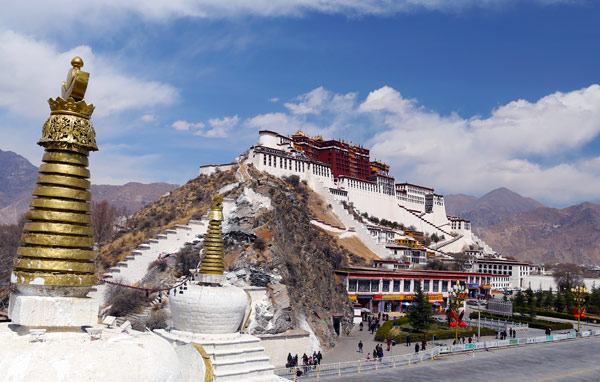

The Potala Palace, a UNESCO World Heritage site that has stood in Lhasa for 1,300 years, has been given two renovations with central government investment. (Photo: Zhu Xingxin/China Daily)
Paintings, cultural relics, frescos, scriptures and buildings at a world heritage site have been safeguarded for future generations thanks to a long-term restoration program.
The central government and the authorities in the Tibet autonomous region have made great efforts to renovate and preserve the Potala Palace, the site's managers said on Thursday.
The palace is one of only three UNESCO World Heritage sites in the region — the others are the Jokhang Temple and the Norbulingka Park.
"The governments invested heavily in the renovation of the site," said Ding Changzheng, the Party secretary at the Potala Palace Management Office.
"More than 204 million yuan ($34 million) was spent during the latest 10-year-long renovation project."
A five-year program costing 53 million yuan was launched at the palace in 1989.
"Famous Tibetan thangka painting artists were invited to contribute to the renovation of the frescos," said Ding.
Yulha Tsering, a firefighter stationed at the site, said: "The palace has been standing in the wind and rain for more than 1,300 years.
"The construction materials were mainly earth, stones and wood, so renovation is very necessary."
Aside from the large-scale restoration projects by the two governments, the palace office has a renovation department that is responsible for daily preservation and maintenance work.
The number of tourists and pilgrims visiting the palace has increased greatly as a result of the restoration efforts, said Ding.
"The daily number of visitors is more than 6,000 in the summer season, compared with 2,000 to 3,000 in the past."
The palace was built in the seventh century by the Tibetan king Songtsen Gampo. It was extended by the fifth Dalai Lama, and was used as the residence of successive Dalai Lamas.
China disqualifies 300 intangible cultural heritage programs
2015-01-2313 items from Tibet listed as National Intangible Cultural Heritage
2015-01-13Newly recognized cultural treasures of Tibet
2014-12-24Museum needed for relics unearthed before China's water diversion
2014-11-02Historic bridges to undergo emergency repairs
2014-07-21Historic ensemble of the Potala Palace, Lhasa
2015-01-19Lhasa sees heaviest snow in two decades
2015-02-15Tibet launches general survey of classics collections
2014-12-05Programs protect Tibet's intangible culture
2014-08-15Copyright ©1999-2018
Chinanews.com. All rights reserved.
Reproduction in whole or in part without permission is prohibited.